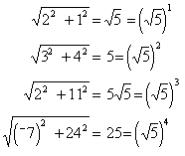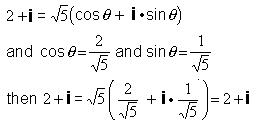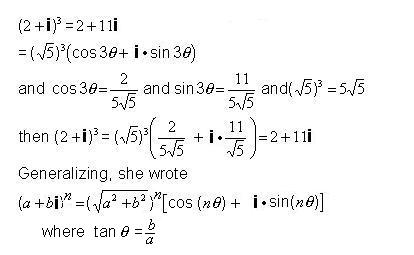^n.jpg)
Ana E., a 10th grader, finds patterns in the graphs of
(2 + i)n
Don asked Ana to graph (2 + i), (2 + i)2, (2 + i)3, (2 + i)4 on the complex or Argand plane. She did that easily. Then he asked her to get the lengths of each vector to the point.
^n.jpg)
Using the pythagorean theorem, Ana found the lengths to be:

and saw the pattern that the original length is squared, cubed and raised to the 4th power to get the new ones. Ana found the angles between the vector and the horizontal (+real) axis to be:

[Note: tan-1 (1/2) means "the angle whose tangent is 1/2"]. She saw the pattern here was that the angles are multiplied by the exponent. So the angle for (2 + i)3 is 3*tan-1 (1/2).
Don showed Ana that

Ana wrote this one:

Great job, Ana!!
Next possible questions: what is (2 + i)1/4 ? and what is eix in terms of cos and sin?
Points on the spiral (1+i)n written different ways
by Don
1.) Showing 9 points on the graph of (1+i)n in the complex plane:
^n12.jpg)
Diagram 1 below shows the 3 points (1+i)1, (1+i)2 and (1+i)3 on the graph, and described different ways:
Diagram 1
Diagram 2 below shows that when one multiplies a vector (1+i) by i, it is rotated 90o counterclockwise:
Diagram 2
The graphs below were all done in Mathematica
2.) ParametricPlot[{Re[(1+I)^n],Im[(1+I)^n]},{n,0,12}]
^ngrpar.jpg)
3.) ParametricPlot[{Re[((![]() )^n)*'^('*n*p/4)],Im[((
)^n)*'^('*n*p/4)],Im[((![]() )^n)*'^('*n*p/4)]},{n,0,12}]
)^n)*'^('*n*p/4)]},{n,0,12}]
^ne^Ipi4.jpg)
4.) ParametricPlot[{Re[((![]() )^n)*(Cos[n*p/4]+'*Sin[n*p/4])],
)^n)*(Cos[n*p/4]+'*Sin[n*p/4])],
Im[((![]() )^n)*(Cos[n*p/4]+'*Sin[n*p/4])]},{n,0,12}]
)^n)*(Cos[n*p/4]+'*Sin[n*p/4])]},{n,0,12}]
^nparcossin.jpg)
See Katie's work #4 where Don introduces her to imaginary and complex numbers. Also see sample problems from Don's book Chapter 11, #10, 11, and 11a.
Coming soon: e, ex, and eix (using the binomial expansion), and sin x and cos x, all as an infinite series, and DeMoivre which can be seen in Ana's work above and in diagram 1 in Don's work.